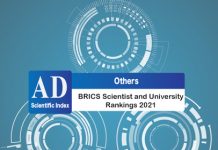BRICS Top 10.000 Scientists “AD Scientific Index 2021” Version 1
AD Scientific Index 2021 BRICS Top 10.000 Scientists Version 1 The AD Scientific Index (Alper-Doger Scientific Index), unlike other systems that provide evaluations of journals and universities, is a ranking and analysis system based on the scientific performance and the added value of the scientific productivity of individual scientists. Furthermore, it provides rankings of institutions based on the scientific characteristics of affiliated scientists. This new index has been developed by Prof. Dr. Murat ALPER (MD) and Associate Prof. Dr. Cihan DÖĞER (MD) by using the total and last 5 years’ values of the i10 index, h-index, and citation scores in Google Scholar. In addition, the ratio of the last 5 years’ value to the total value of the abovementioned indexes is used. Using a total of nine parameters, the “AD Scientific Index” shows the ranking of an individual scientist by 12 subject (Agriculture & Forestry, Arts, Design and Architecture, Business & Management, Economics & Econometrics, Education, Engineering & Technology, History, Philosophy, Theology, Law / Law and Legal Studies, Medical and Health Sciences, Natural Sciences, Social Sciences and Others), 256 branch, 11,700 institution of employment, 186 country, 11 region (Africa, Asia, Europe, North America, Latin America, Oceania, Arab Leageu, EECA, BRICS, USAN and COMESA) and in the world. The “AD Scientific Index” is the first and only study that shows the total and the last five-year productivity coefficients of scientists based on the h-index and i10 index scores and citations in Google Scholar. In other words, the “AD Scientific Index” provides both the academic ranking and analysis results. One of the major differences of the AD Scientific Index is the provision of the last five years’ scores and the total scores of the h-index and the i10 index, and the total and last five years’ number of citations. Other unique differences of the AD Scientific Index include rankings in all fields and subjects of scientific interest and the emphasis on the scientific productivity of the scientist. Thus, scientists and universities can obtain their academic rankings and monitor developments in the ranking over time. We are an independent organization that does not receive support from any institution, organization, country, or fund. Your contributions will shed light on us in our constant efforts while we are aiming the best for software improvements and data size and accuracy.





